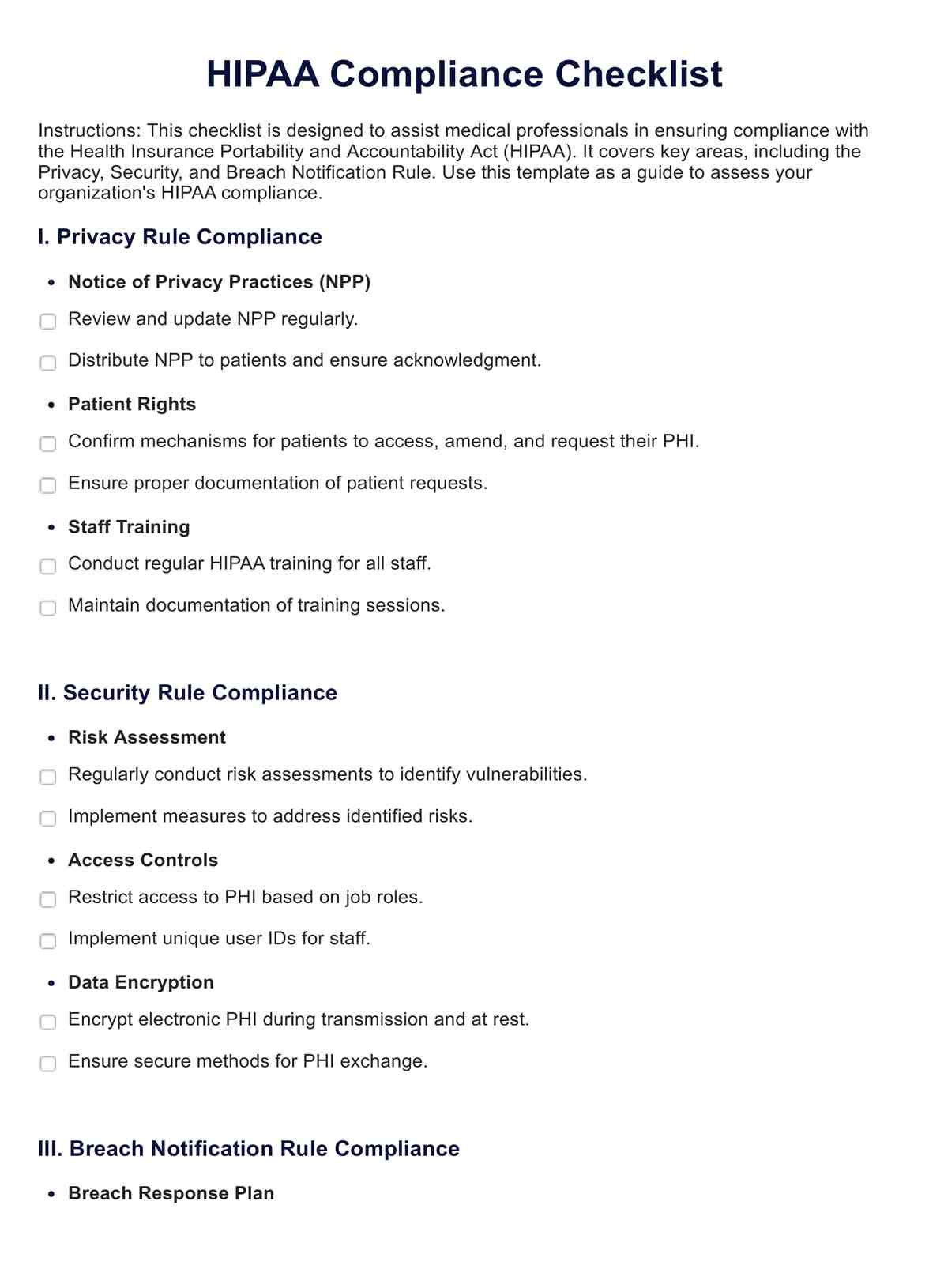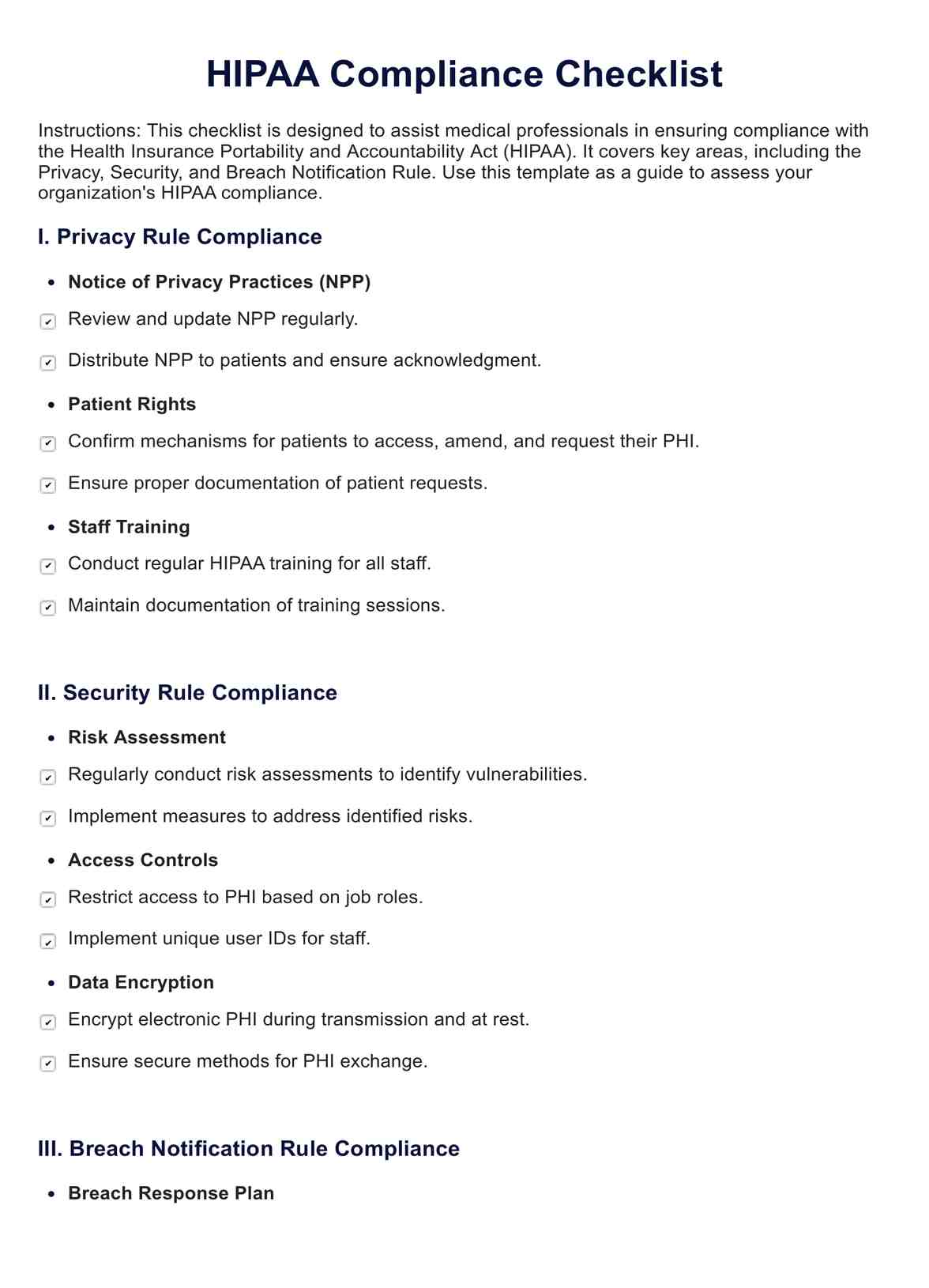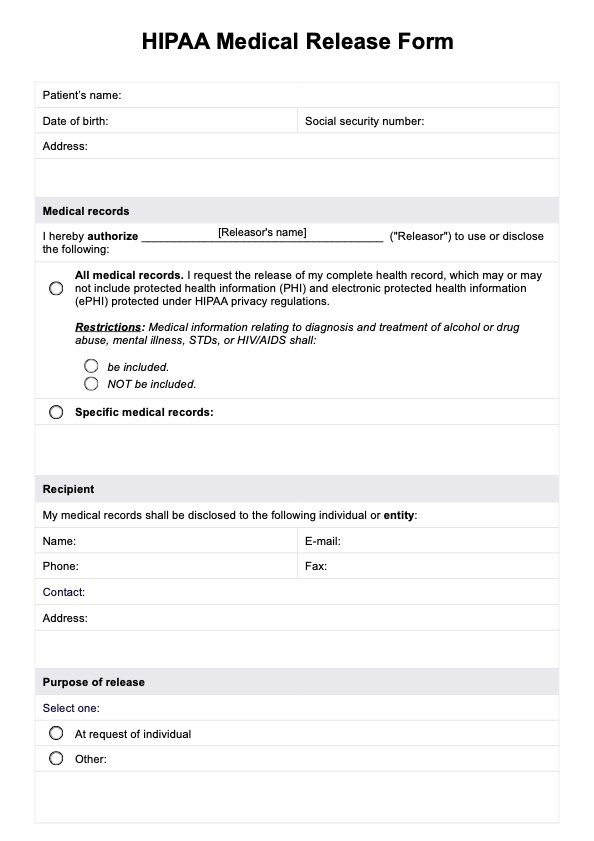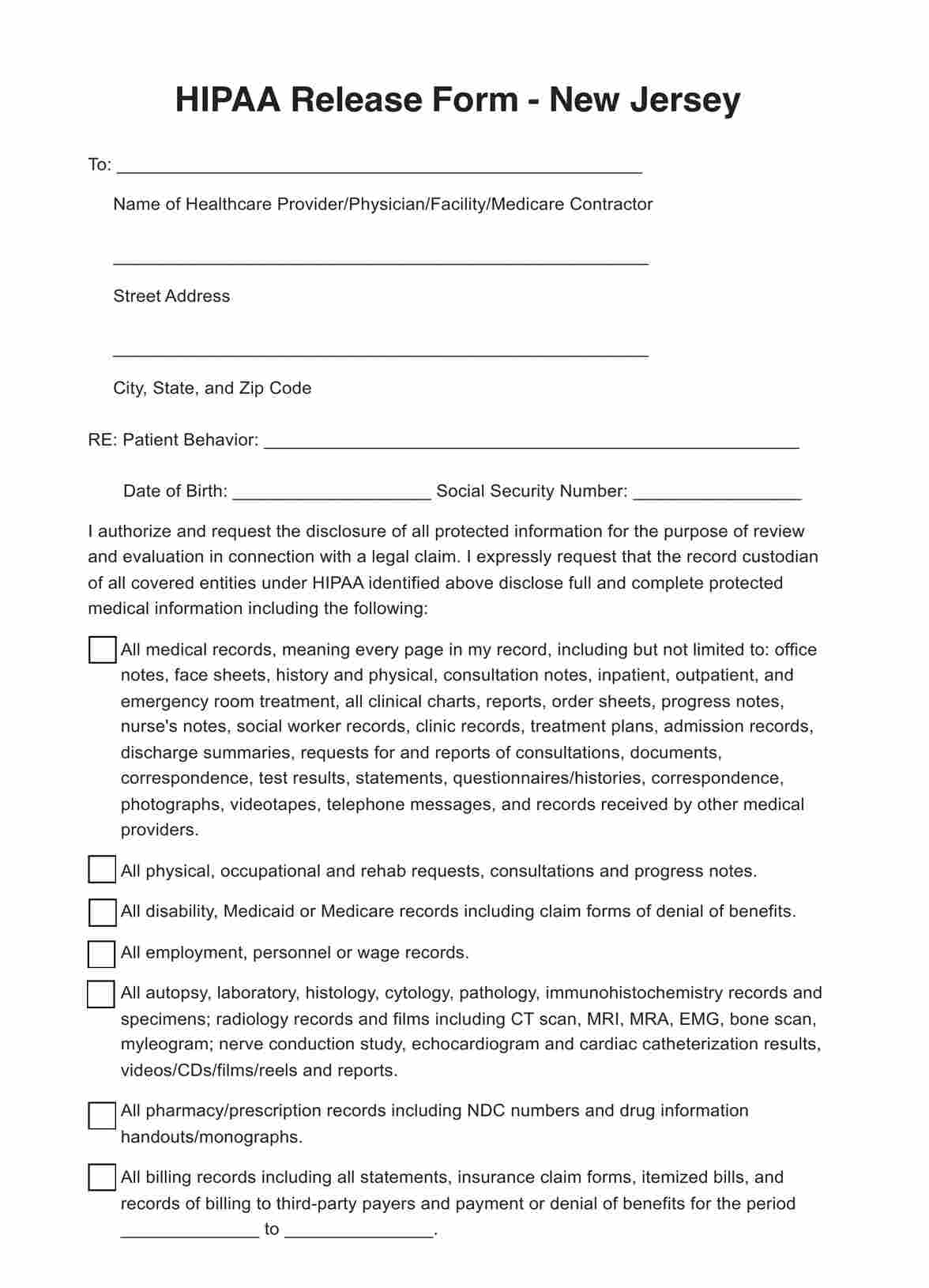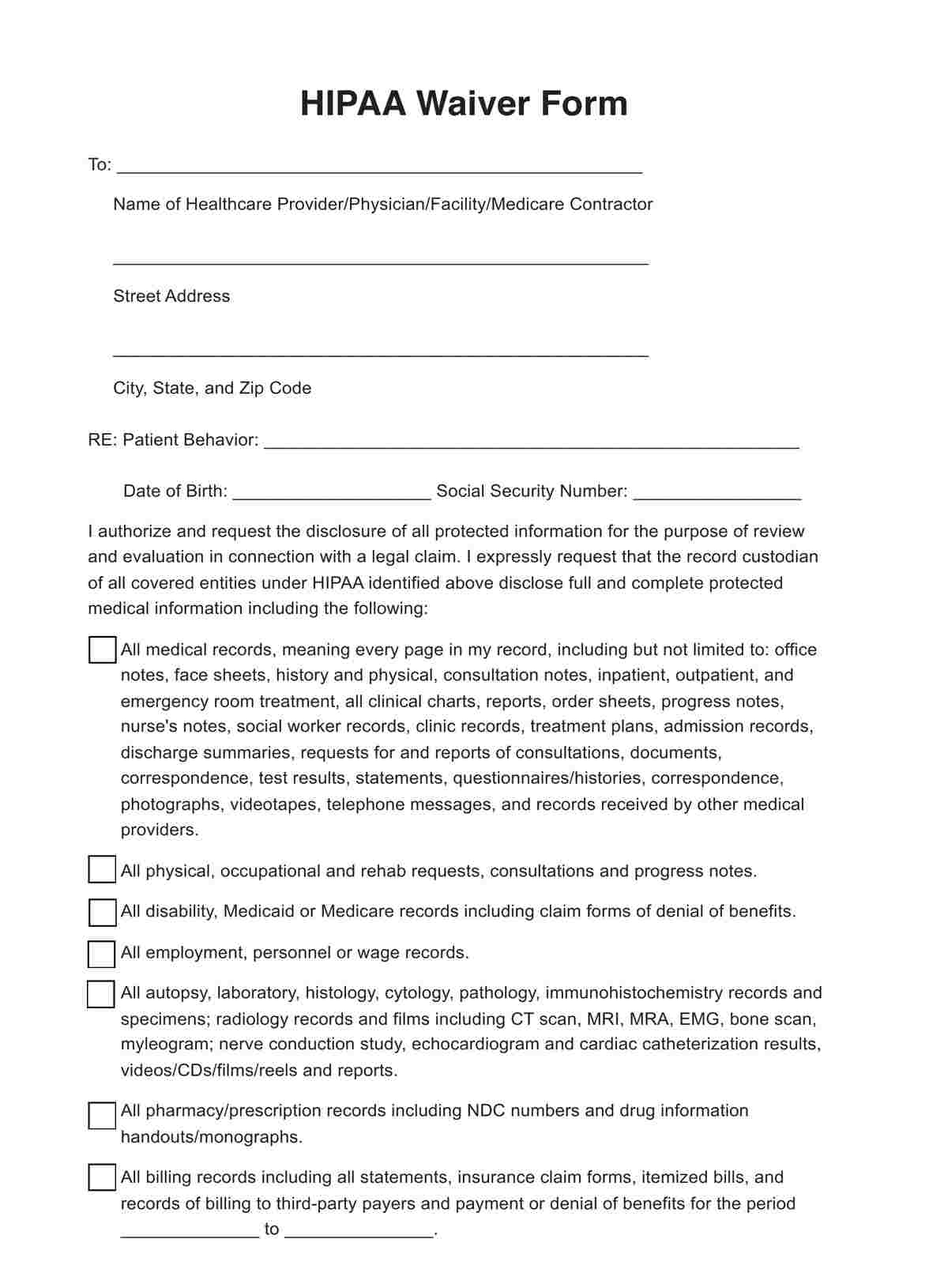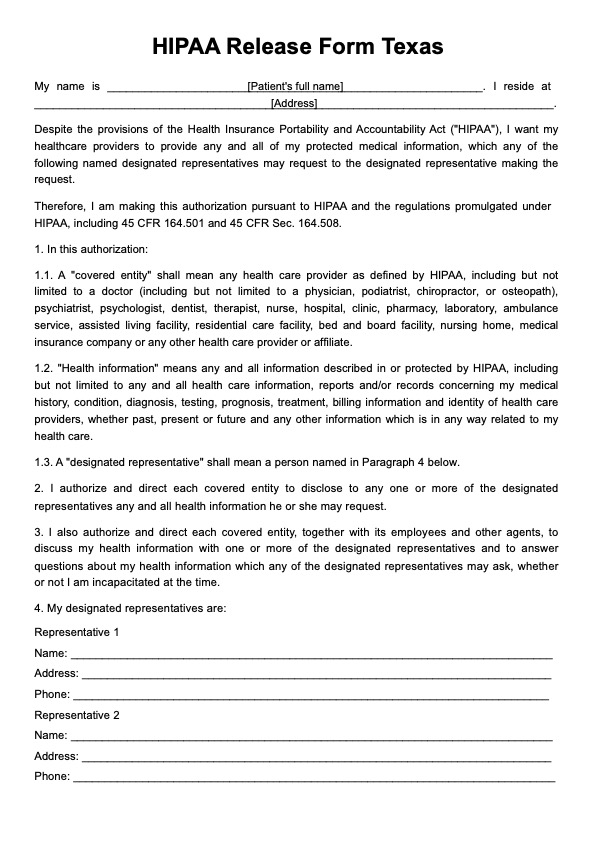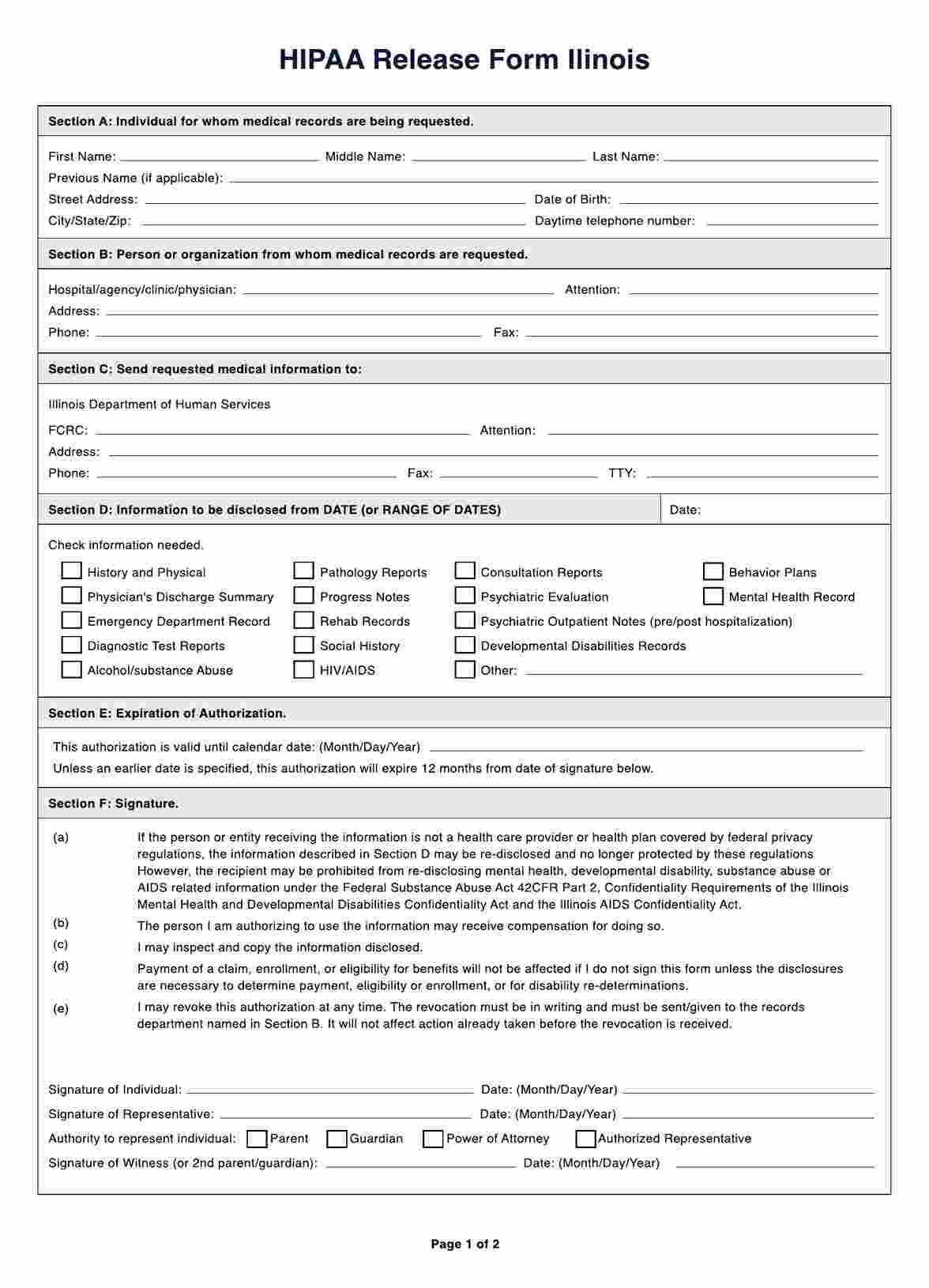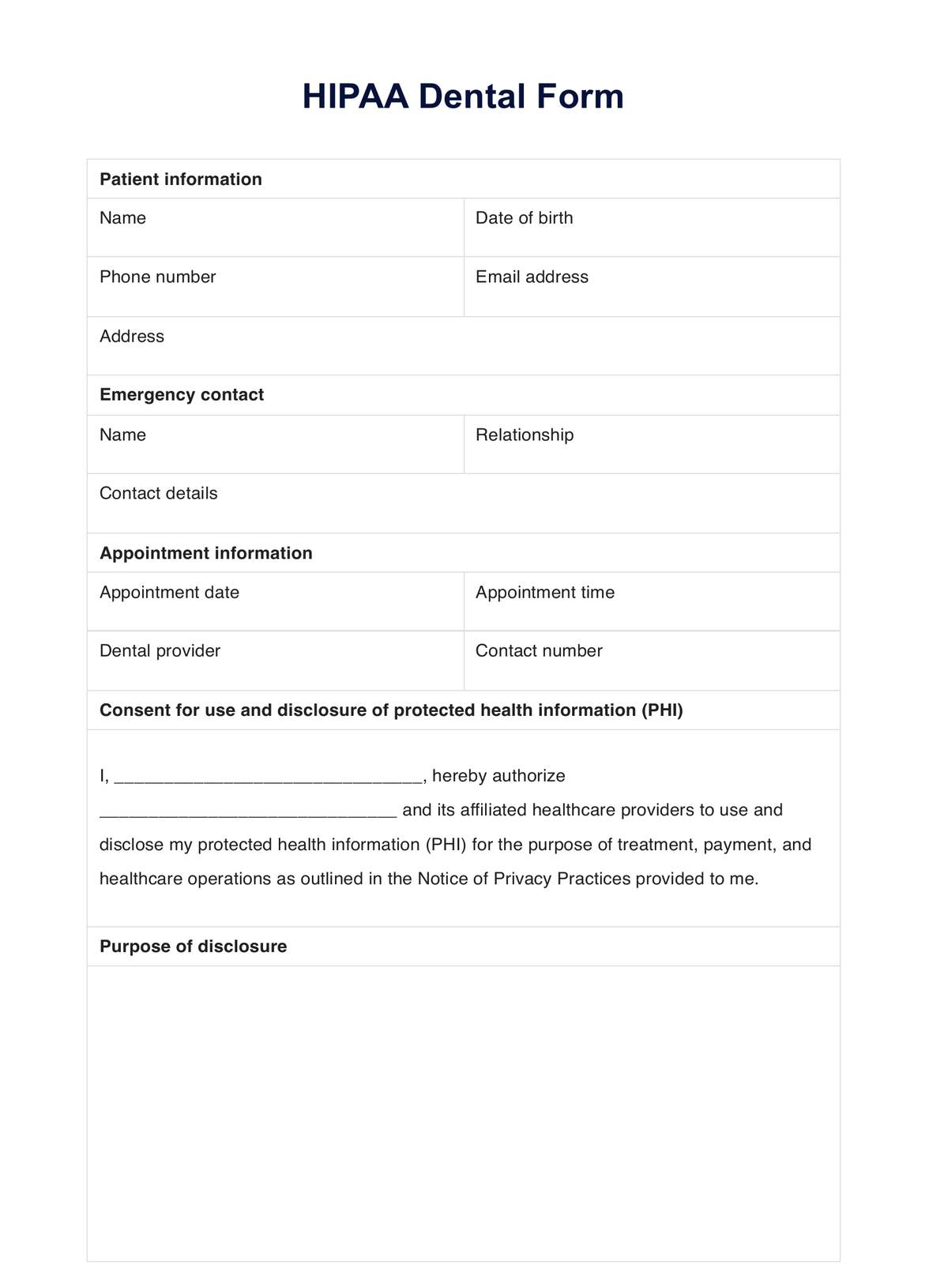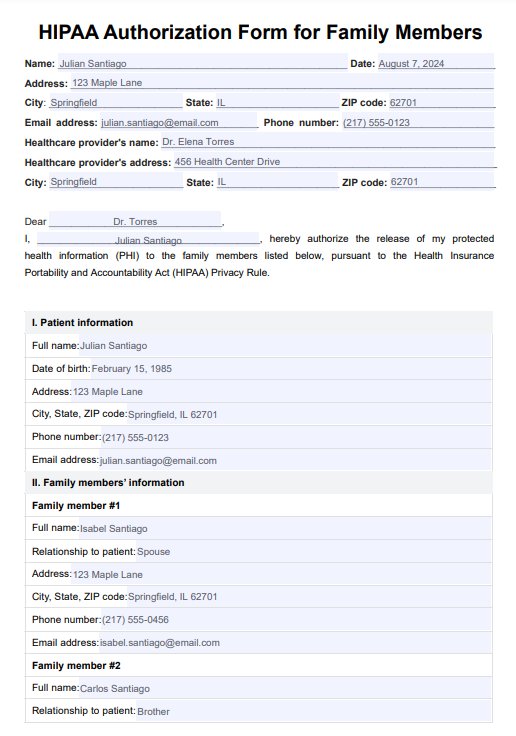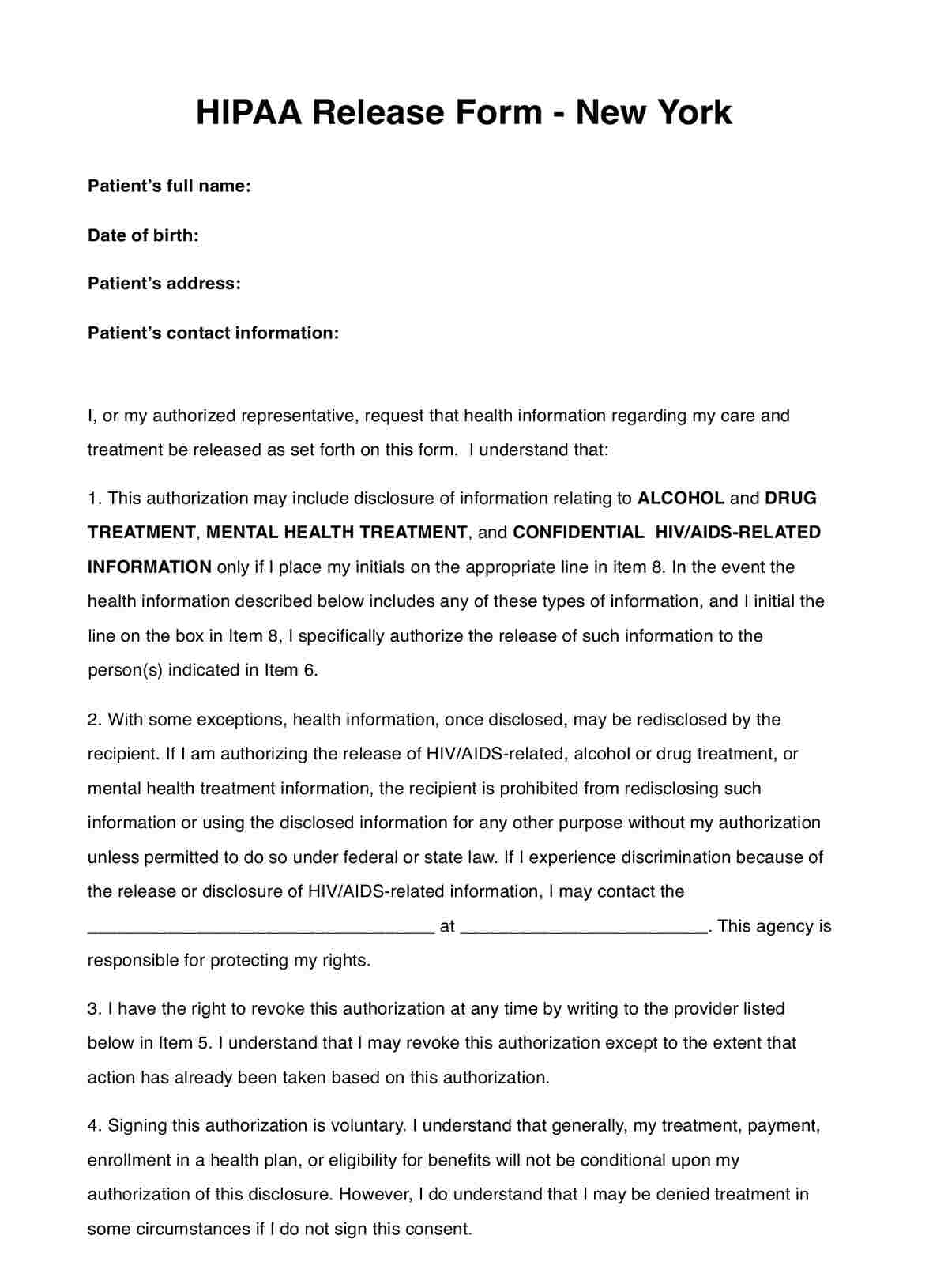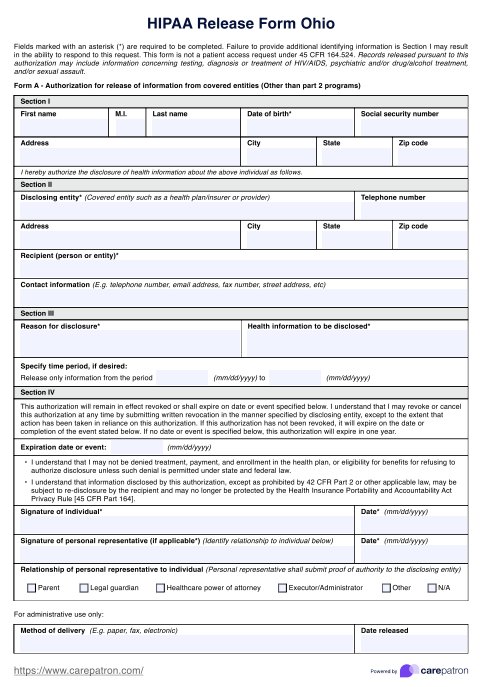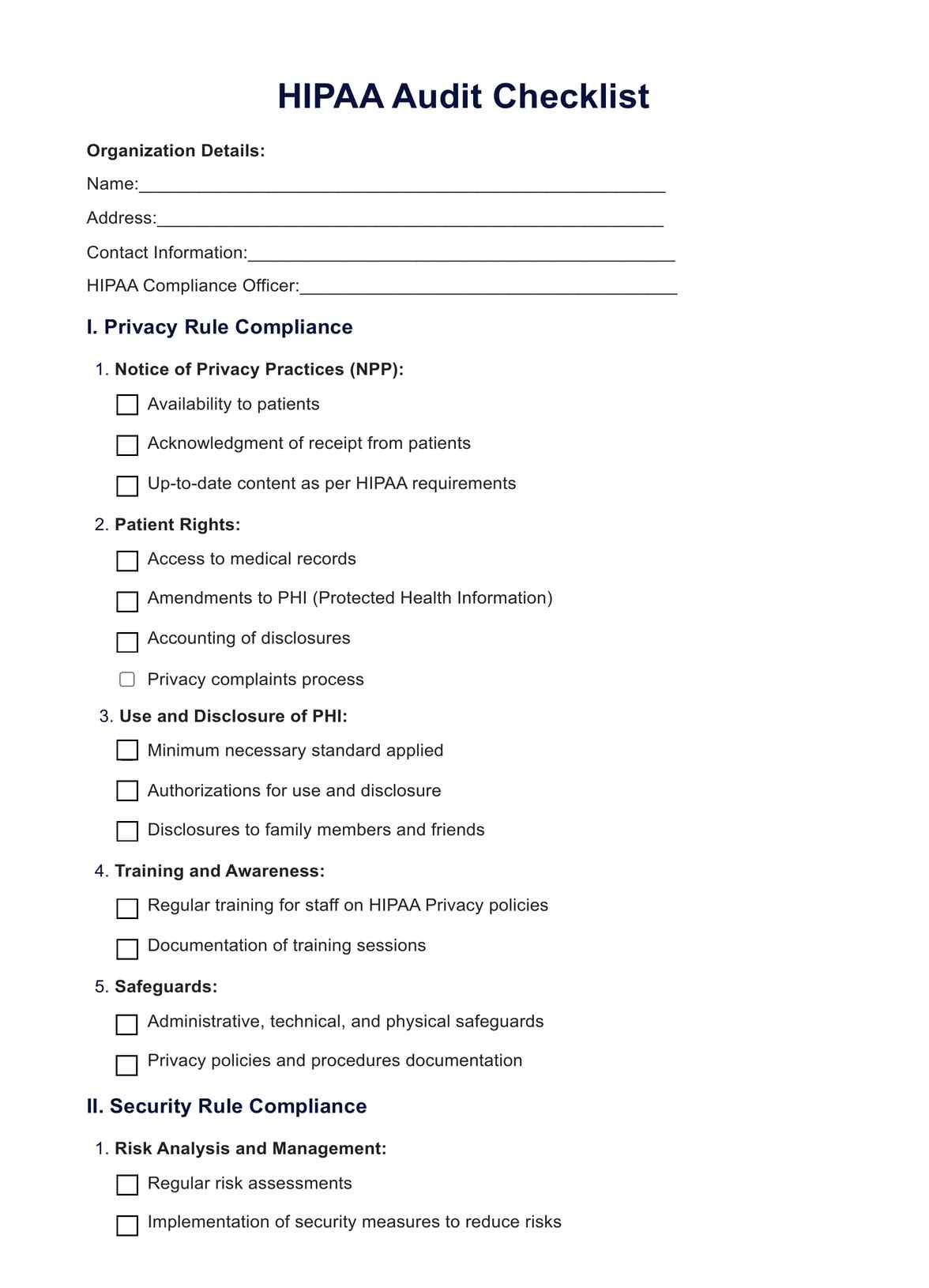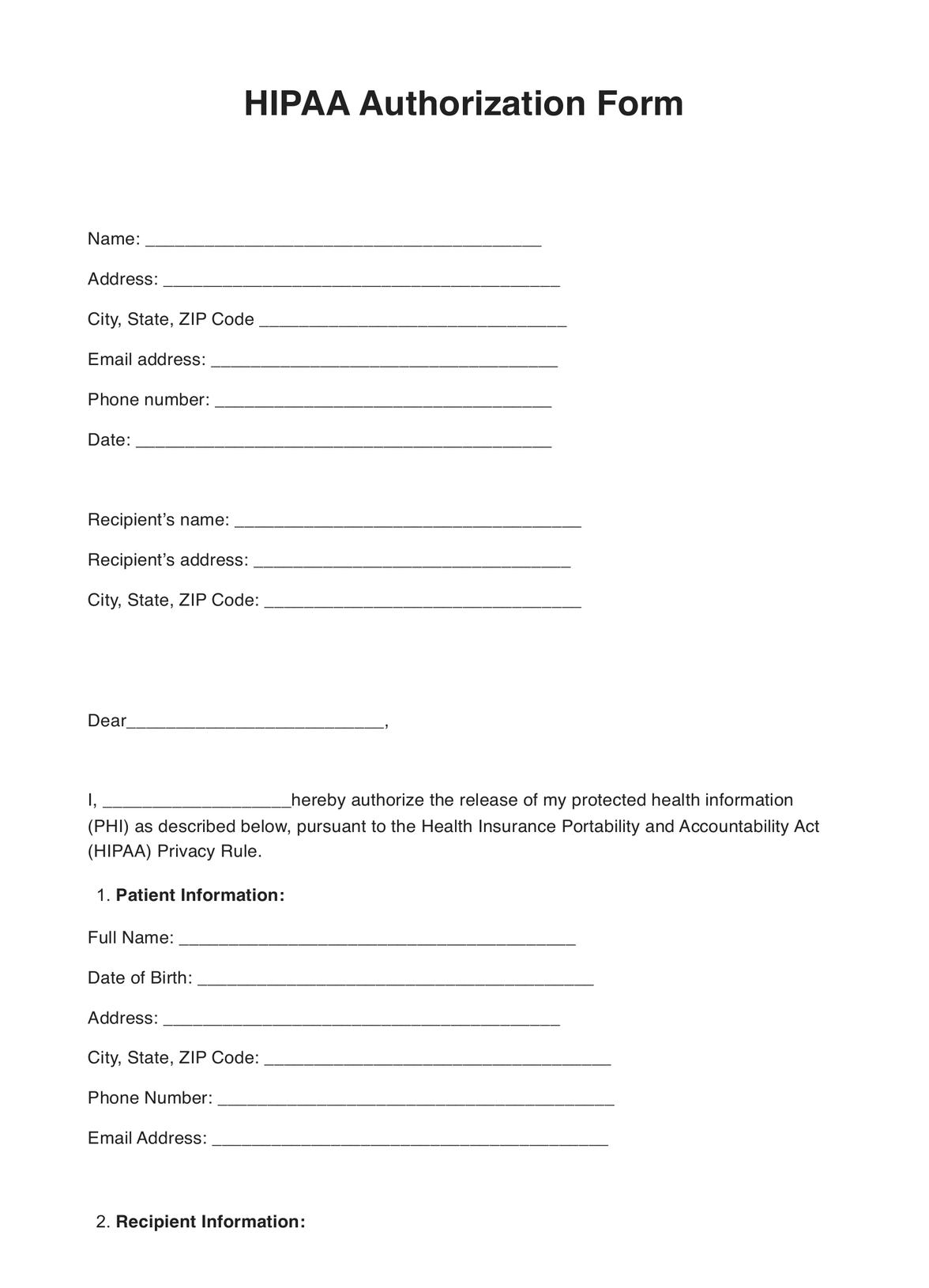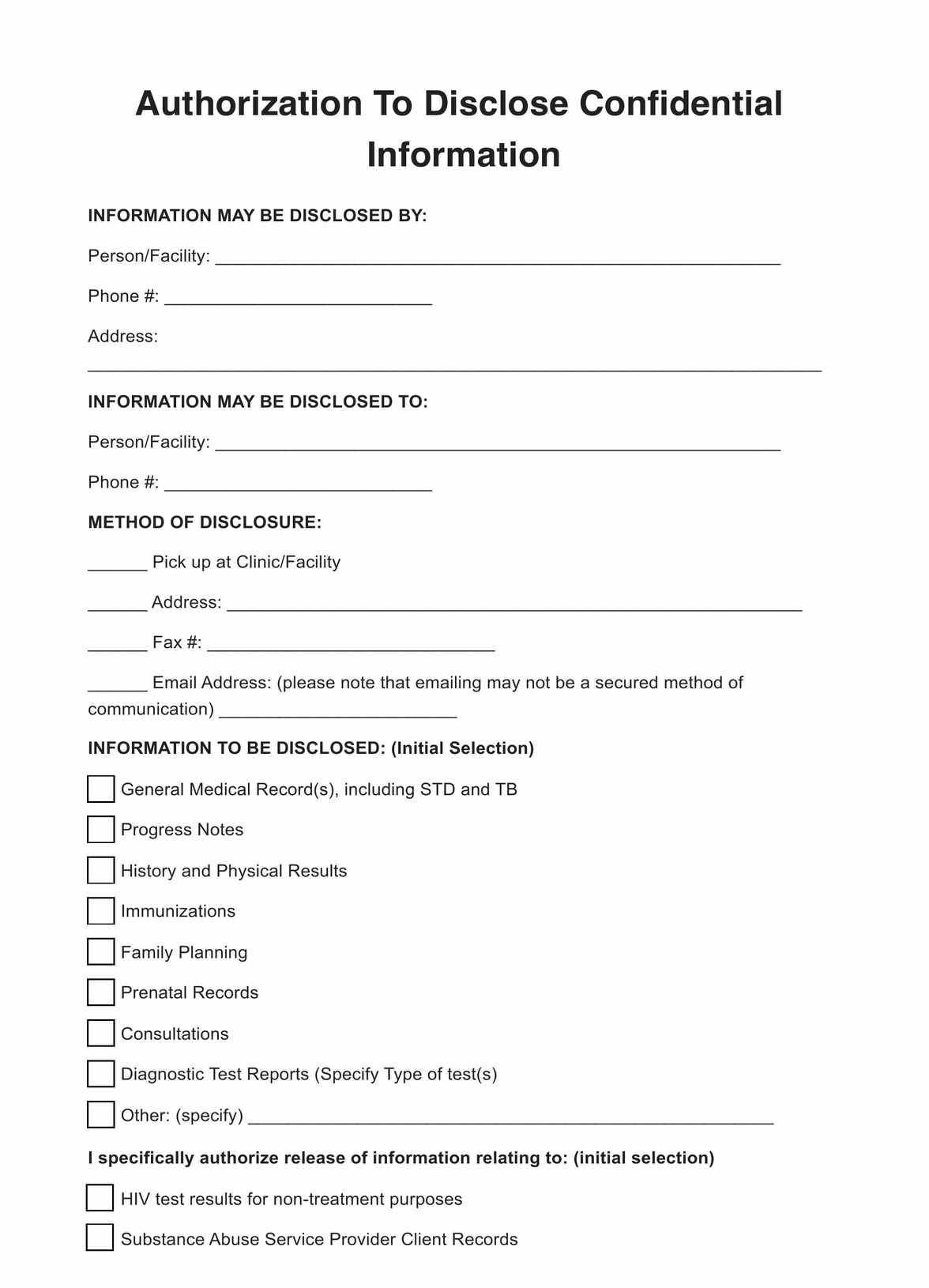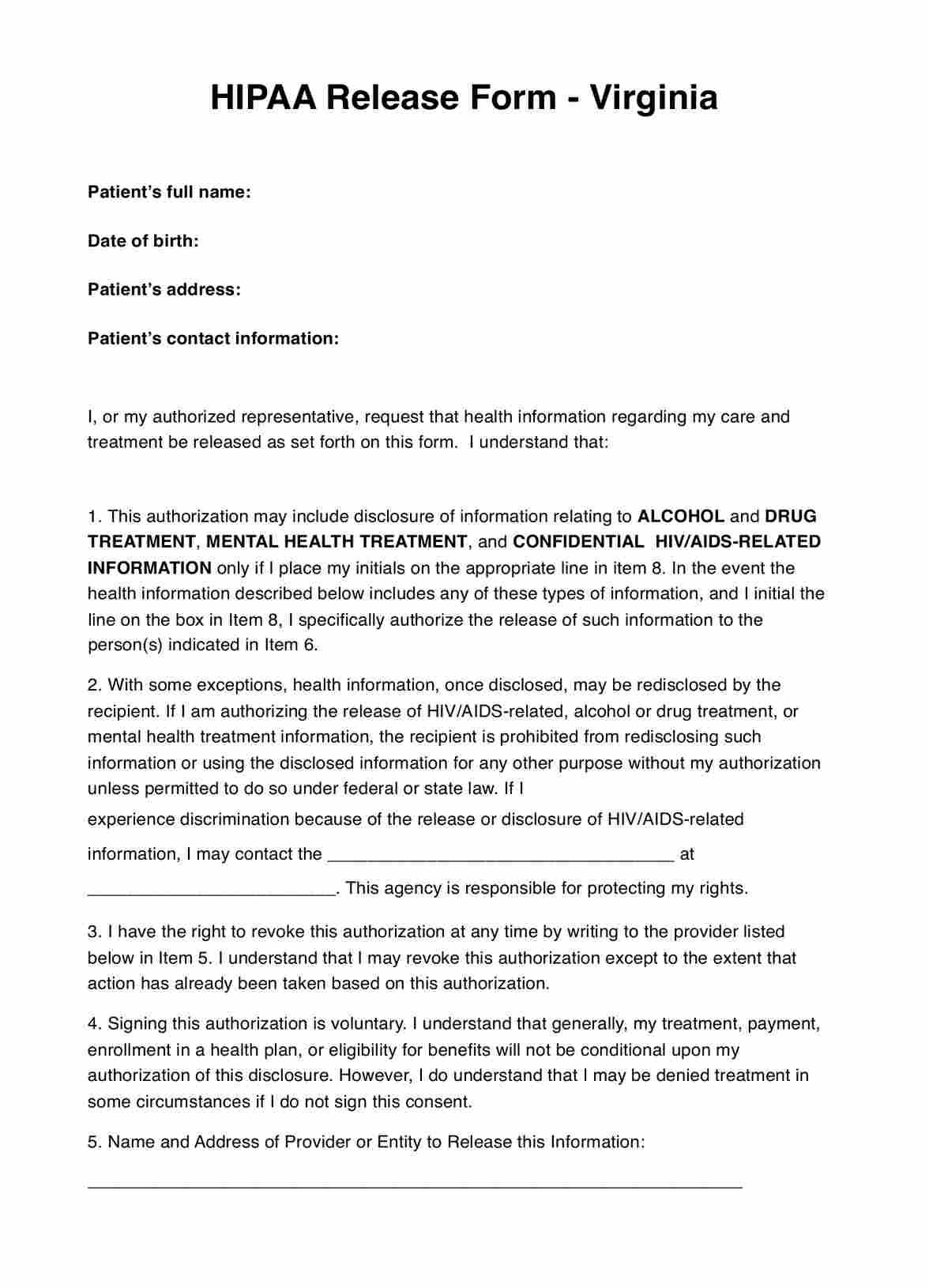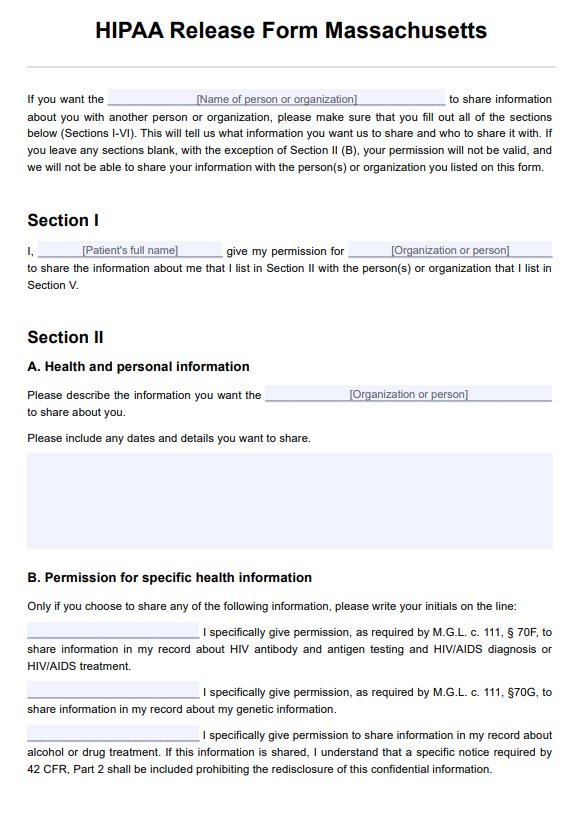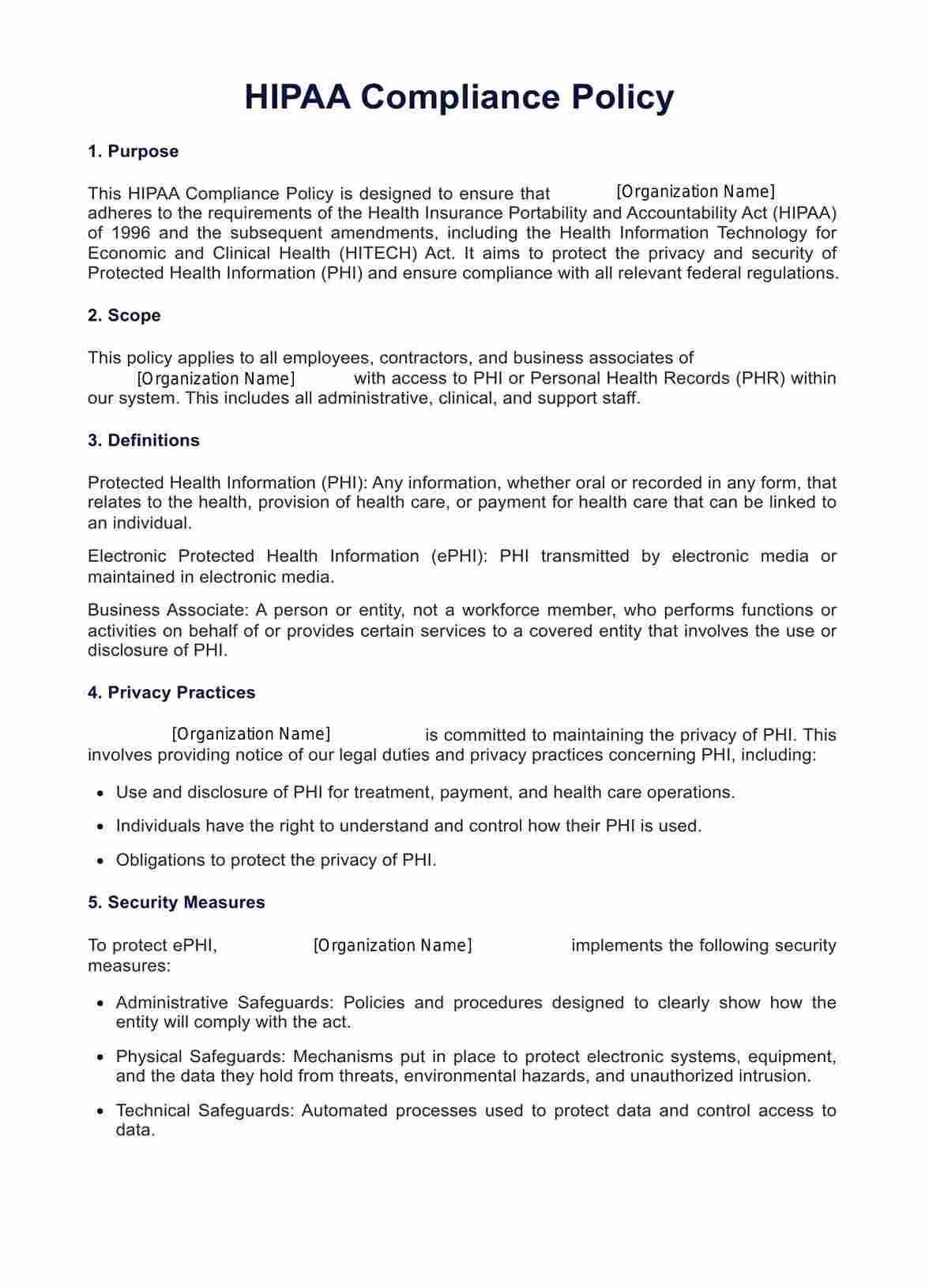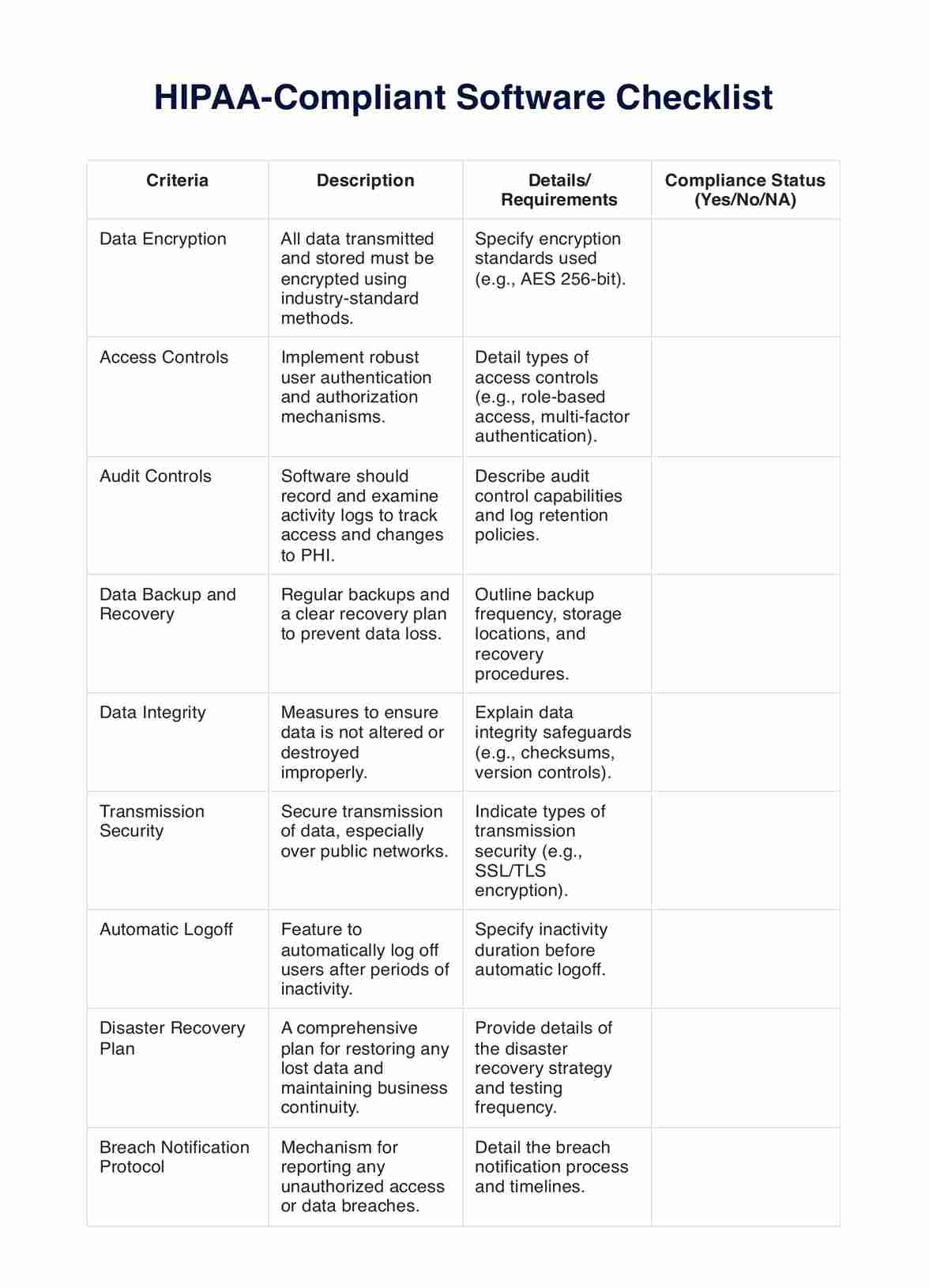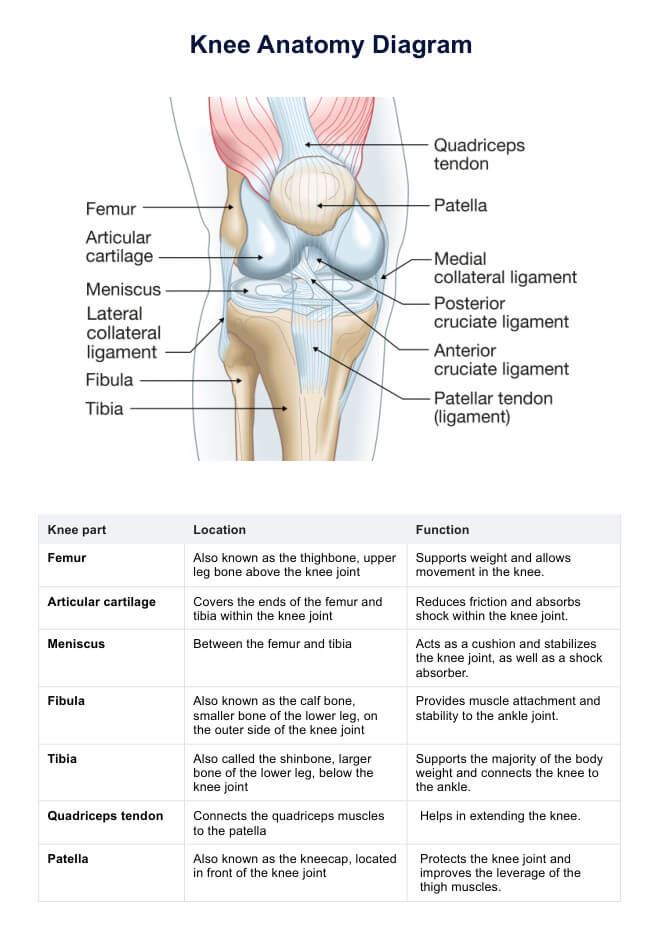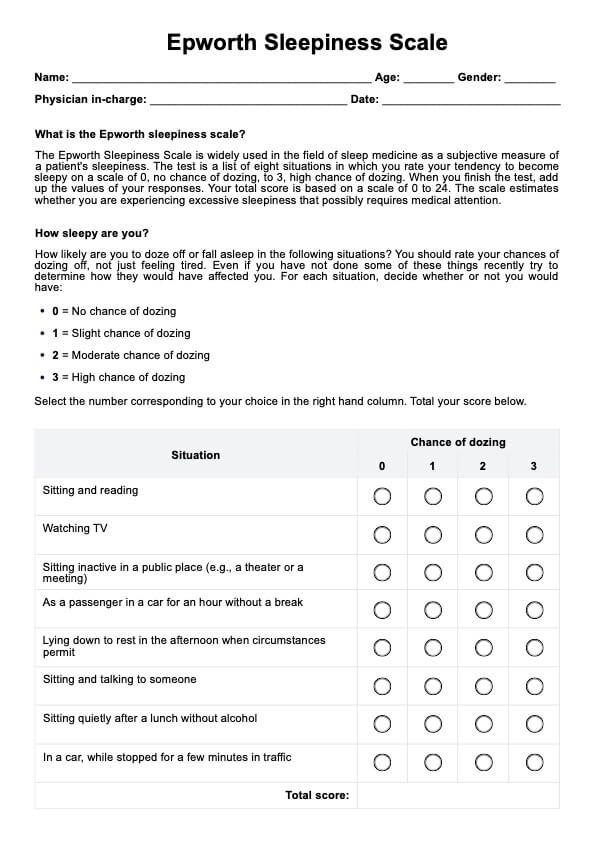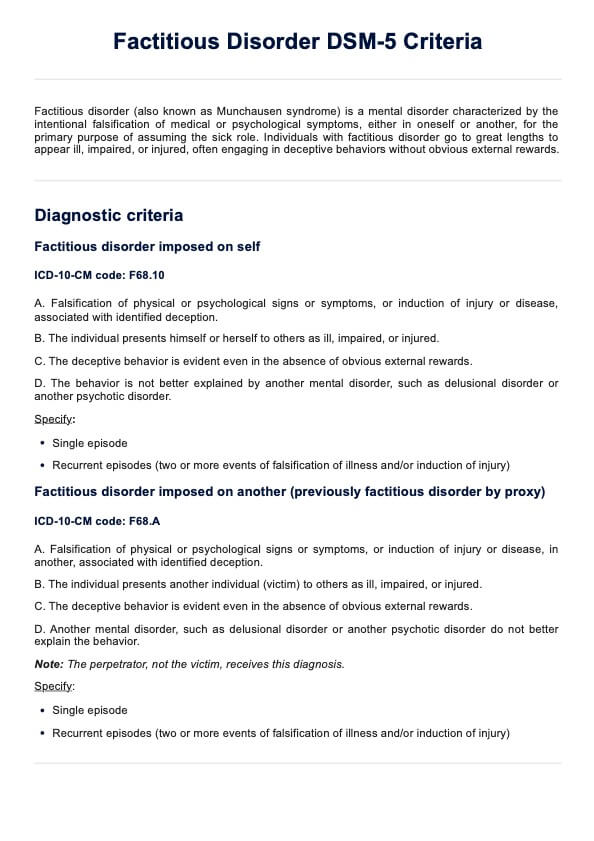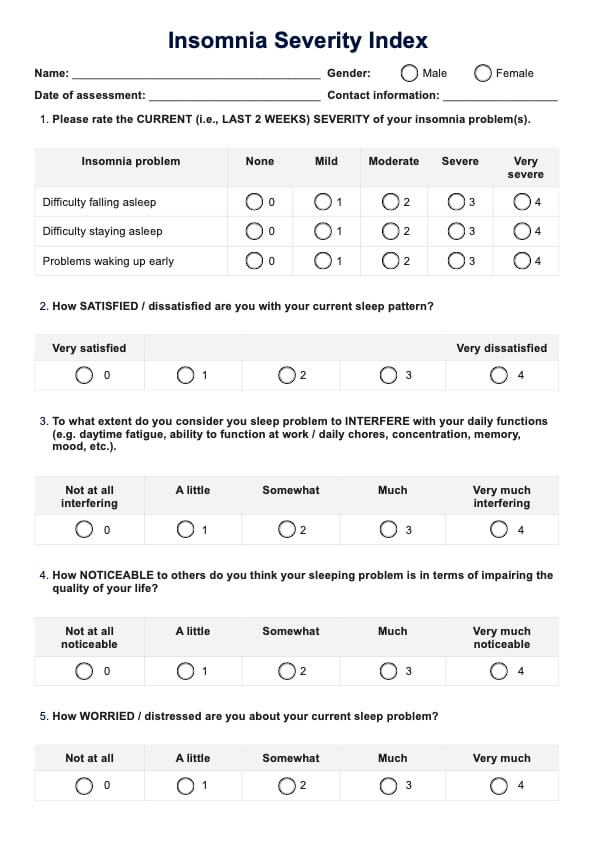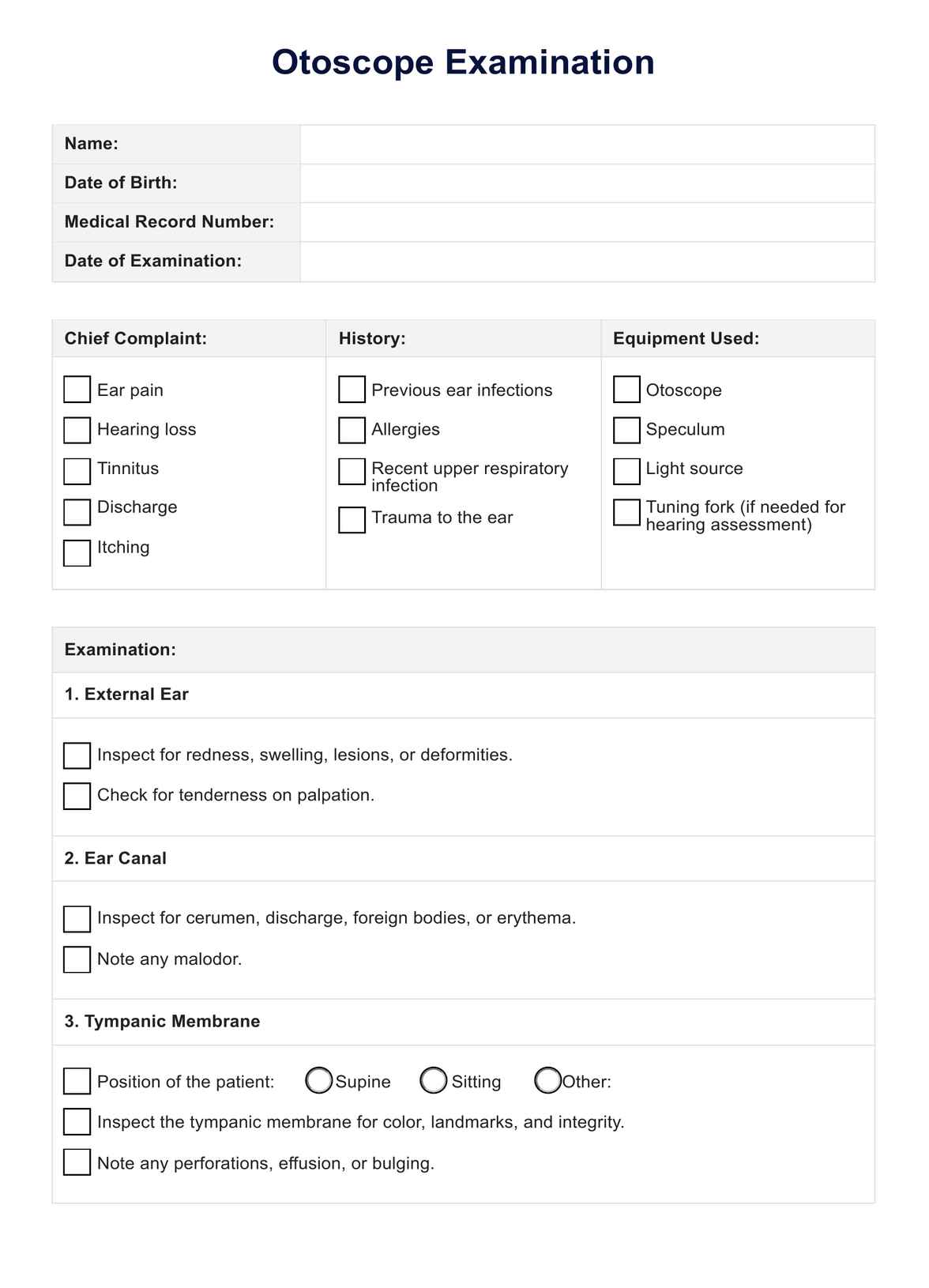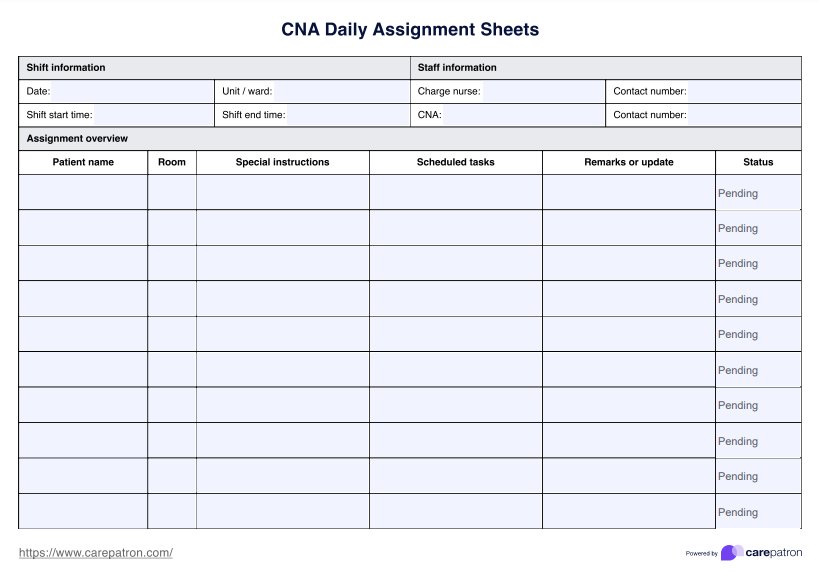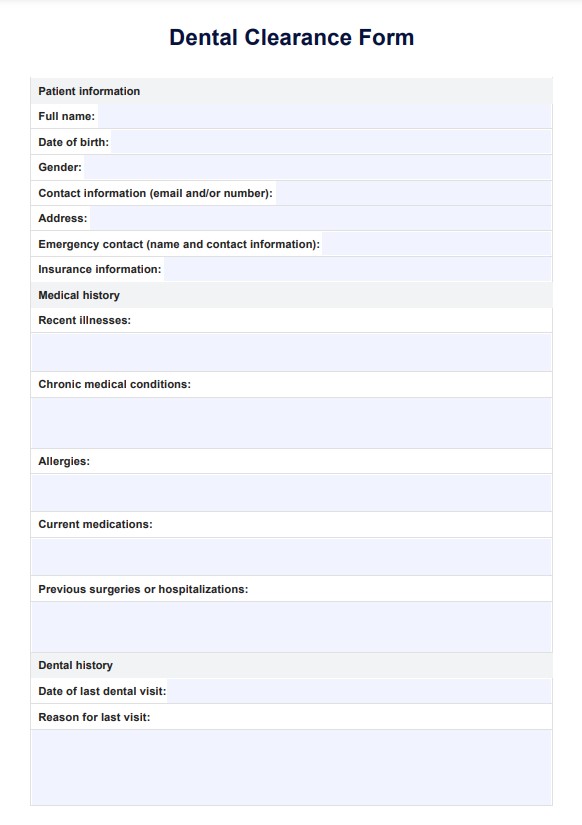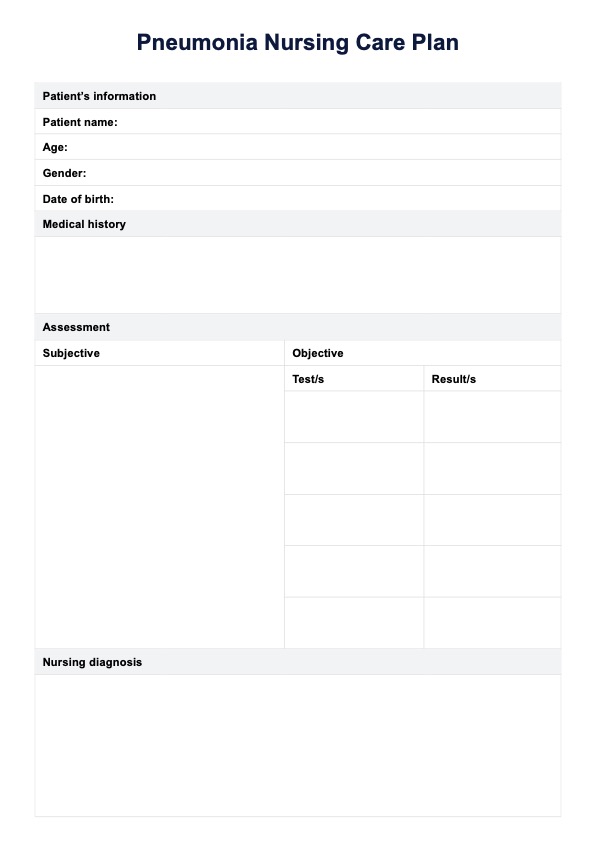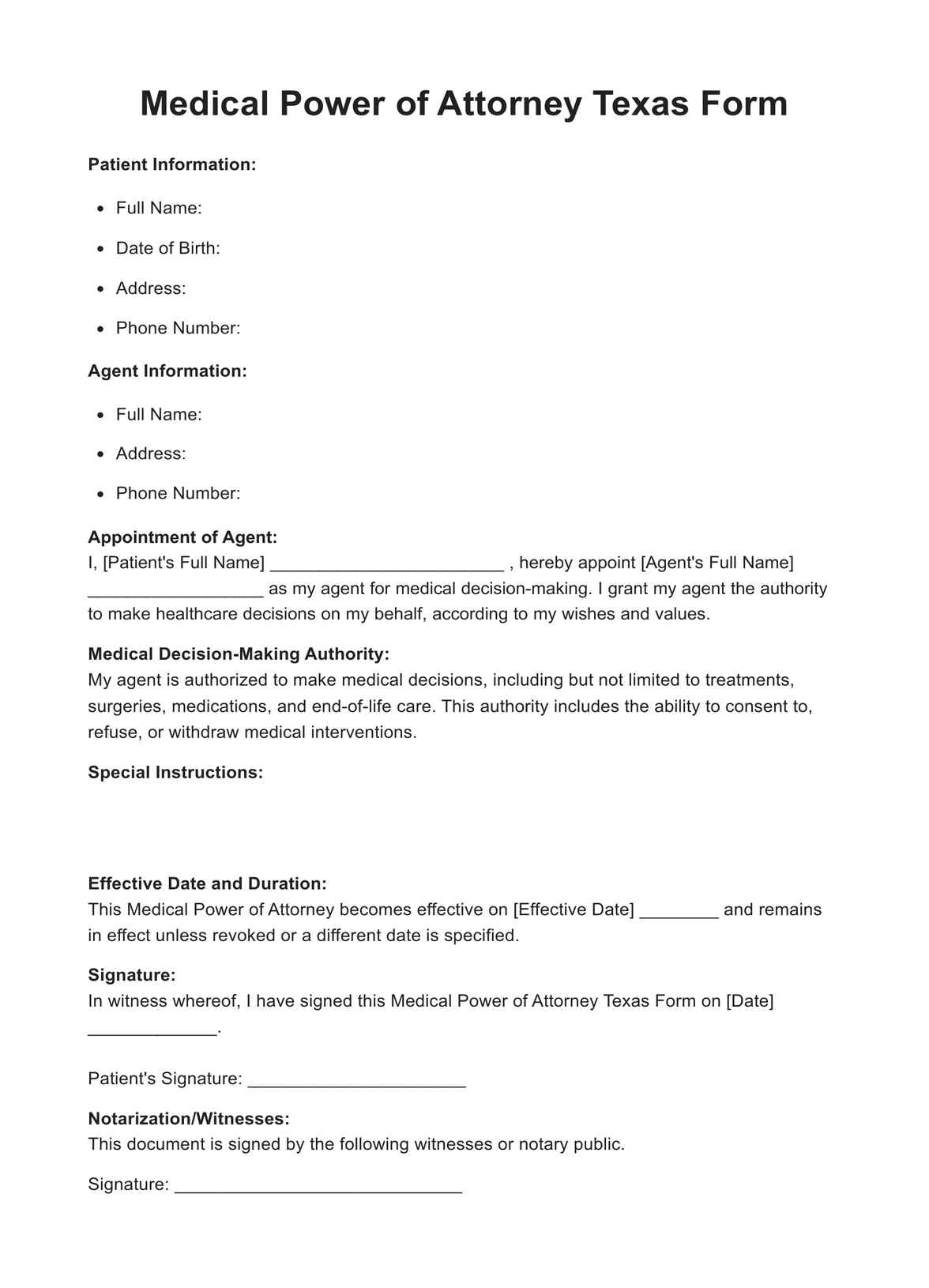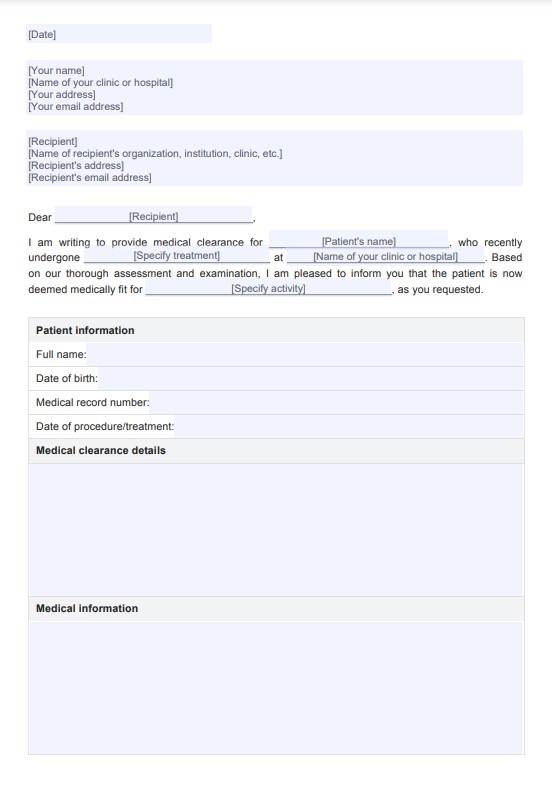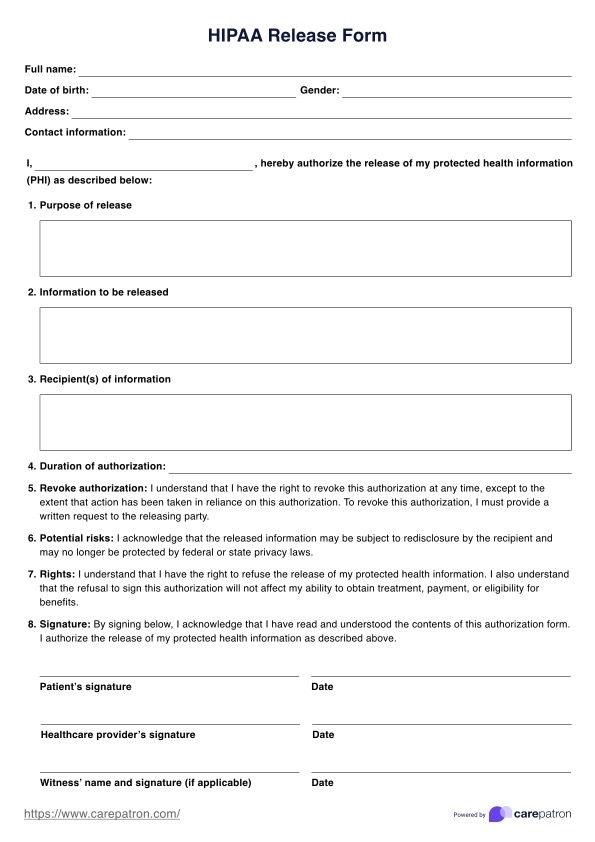HIPAA
Ensure HIPAA compliance with our comprehensive HIPAA checklist. Protect patient data and navigate regulatory requirements seamlessly. Download now!


What is a HIPAA Checklist?
A Health Insurance Portability and Accountability Act (HIPAA) Checklist is a comprehensive tool designed to help healthcare organizations and entities ensure compliance with the regulations outlined in the HIPAA legislation. Enacted in 1996, HIPAA aims to safeguard the privacy and security of individuals' health information and establishes standards for the electronic exchange of health information.
A HIPAA compliance checklist ensures healthcare professionals meet the necessary standards. It covers critical aspects like administrative, physical, and technical safeguards. It typically encompasses various aspects of the law, including privacy, security, and breach notification rules. These rules collectively set standards for HIPAA-covered entities, including health plans and healthcare providers handling sensitive patient information (Alder, 2024).
A typical HIPAA compliance requirements checklist covers the following:
- Privacy rule compliance: The HIPAA privacy rule ensures that policies and procedures are in place to protect patients' health information privacy.
- Security rule compliance: A HIPAA Security Rule Checklist ensures electronic protected health information (e-PHI) security and confidentiality. This rule establishes standards for safeguarding sensitive patient data and outlines the necessary measures to protect against potential security threats (U.S. Department of Health and Human Services, 2019).
- Breach notification rule compliance: Establish procedures to detect and respond to data breaches and notify affected individuals and relevant authorities.
- Employee training: Providing ongoing training to staff members regarding HIPAA regulations, ensuring they know their responsibilities in maintaining patient privacy.
- Risk assessment: Conduct regular risk assessments to identify and mitigate potential vulnerabilities in handling health information.
- Business associate agreements: Ensuring that appropriate agreements are in place with vendors and partners who have access to PHI, holding them accountable for maintaining the confidentiality and security of the information.
Regularly using a HIPAA Checklist helps organizations identify gaps in compliance, address potential risks, and avoid HIPAA violations. It is a valuable tool in the healthcare industry's efforts to remain HIPAA-compliant, safeguard patient information, and maintain trust in handling sensitive health data.
HIPAA Template
HIPAA Example
How does it work?
Using our HIPAA compliance checklist PDF involves a systematic process. The following steps outline how the checklist works:
Step 1: Conduct a comprehensive review
Begin by thoroughly examining your current HIPAA compliance status. This step involves reviewing and updating your notice of privacy practices (NPP), assessing patient rights mechanisms, evaluating staff training programs on HIPAA regulations, and conducting a risk analysis or HIPAA compliance program to identify vulnerabilities in your data protection systems. This initial review provides a baseline understanding of your practice's compliance level and highlights areas that require immediate attention.
Step 2: Implement security rule compliance
Based on your review's findings, implement or strengthen security measures with digital and physical safeguards and a breach response plan. These measures form the backbone of your HIPAA compliance strategy, protecting sensitive patient information from unauthorized access or disclosure.
Step 3: Manage business associates and documentation
This involves reviewing and updating business associate agreements (BAAs) with vendors handling PHI, maintaining detailed records of all HIPAA compliance efforts, and regularly reviewing and updating policies and procedures. Proper documentation and management of business relationships are crucial for demonstrating compliance in case of an audit.
Step 4: Establish ongoing compliance processes
HIPAA compliance is not a one-time effort but an ongoing process. Conduct periodic internal audits of HIPAA compliance, keep staff informed of updates to policies and procedures, and foster a culture of awareness and responsibility regarding patient privacy. Regular audits and continuous staff education ensure that your practice is on its way to achieving HIPAA compliance.
When would you use this checklist?
Our ultimate HIPAA compliance checklist is a crucial resource for various practitioners within the healthcare industry, providing a structured approach to ensuring compliance with the Health Insurance Portability and Accountability Act. Here are instances when the use of the HIPAA Checklist is particularly relevant:
New compliance initiatives
When healthcare organizations are implementing new systems, technologies, or processes that involve the handling of patient information, the HIPAA Checklist becomes invaluable in ensuring that these initiatives align with regulatory standards.
Periodic audits and assessments
Conducting regular internal audits and assessments is a proactive approach to maintaining compliance. The HIPAA Checklist is a comprehensive tool for practitioners to review and verify HIPAA compliance systematically.
Training and onboarding
Organizations can use the checklist to educate employees about their responsibilities under HIPAA rules and reinforce the importance of safeguarding patient information and electronic health records when onboarding new staff or conducting periodic training sessions.
Response to security incidents
In the aftermath of a security incident or data breach, the checklist becomes instrumental in assessing the extent of the breach, identifying vulnerabilities, and implementing corrective measures to prevent future occurrences.
Vendor and partner relationships
Before establishing or renewing partnerships with external entities that handle patient data, organizations can use the checklist to ensure that proper business associate agreements are in place, outlining expectations for HIPAA compliance.
Policy and procedure updates
Whenever organizational policies, procedures, or workflows change, practitioners can use the HIPAA Checklist to verify that these modifications align with HIPAA regulations and do not compromise patient privacy or data security.
Government audits or investigations
Healthcare practitioners can use the checklist to conduct an internal assessment in response to government audits or investigations. This ensures readiness and identifies and rectifies any compliance gaps before external scrutiny.
References
Alder, S. (2024, February 9). HIPAA compliance checklist. HIPAA Journal. https://www.hipaajournal.com/hipaa-compliance-checklist/
U.S. Department of Health and Human Services. (2019, August 29). Security rule guidance material. https://www.hhs.gov/hipaa/for-professionals/security/guidance/index.html
Commonly asked questions
To achieve HIPAA compliance, healthcare organizations must implement safeguards to protect patient privacy and secure protected health information (PHI). This includes conducting regular risk assessments to identify vulnerabilities, establishing comprehensive policies and procedures, training employees on HIPAA regulations, and ensuring that physical and electronic access to PHI is restricted. Maintaining regular data backups is crucial for protecting patient information and ensuring data recovery in case of a breach or system failure.
The three important rules for HIPAA compliance are the Privacy Rule, the Security Rule, and the Breach Notification Rule. The Privacy Rule establishes national standards for the protection of PHI. The Security Rule mandates safeguards to protect electronic protected health information (ePHI) through physical, technical, and administrative safeguards. The Breach Notification Rule requires covered entities to notify affected individuals and the OCR in case of a breach of unsecured PHI.
HIPAA compliance documentation refers to the records and policies that organizations must maintain to demonstrate adherence to HIPAA regulations. Key documentation includes policies and procedures, risk assessments, employee training logs, business associate agreements, and records of incidents involving protected health information (PHI).


